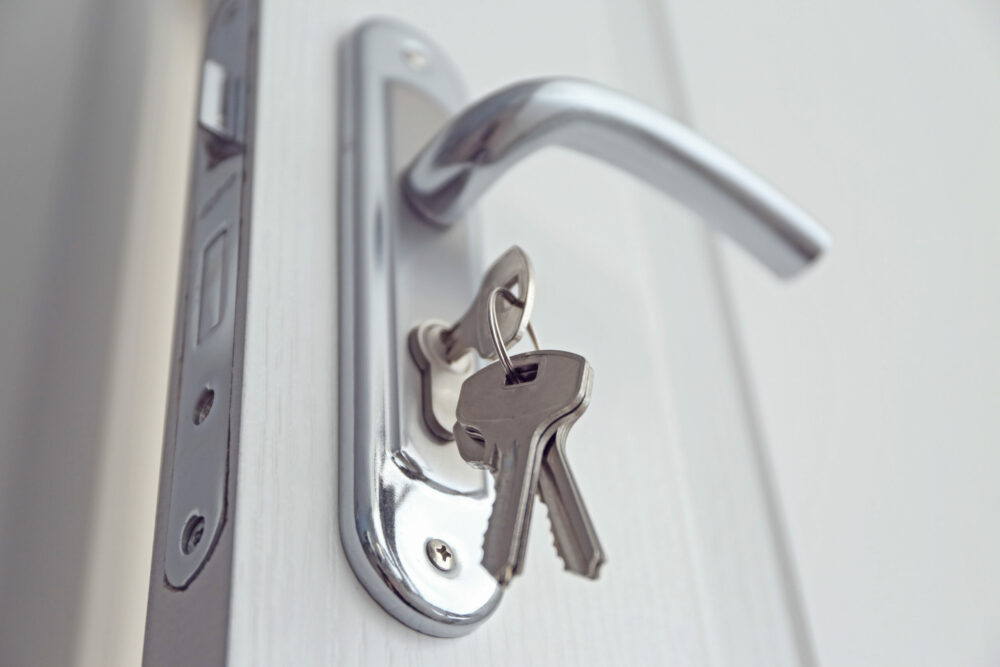The results from the 2024 Campus Safety Access Control and Lockdown Survey are in, and like in surveys from previous year’s, K-12 schools, school districts, institutions of higher education, and hospitals continue to grow the types of access control, locks, visitor management and door hardware technologies they are deploying at their facilities.
Download Campus Safety’s 2024 Access Control and Lockdown Deep Dive
However, there have been some significant shifts in the adoption rates of some systems compared to two years ago when survey participants were previously asked which solutions their organizations were currently using. The percentage of respondents using visitor management software has jumped 18% since 2022, from 33% to 51%. When broken down by sector, however, there are some big differences as well: 69% of K-12 school respondents now have visitor management software, compared to only 27% of healthcare respondents, and 16% of survey takers from colleges and universities.
The most common ways survey participants say their campuses check visitor identity before allowing guests on campus are police/security officers or staff (48%) and audio or video intercom (49%). Nearly a quarter of all participants (24%) don’t check visitor identity.
But again, when broken down by sector, only 6% of K-12 respondents don’t verify visitor identity while 67% of higher education and 30% of healthcare respondents said they don’t check visitor IDs. These aren’t surprising findings considering the open nature of most college campuses and many healthcare facilities, compared to K-12 schools/districts.
More Campuses Adopt Window Security Film, Secure Vestibules, Access Control Software
More of this year’s survey participants now have window safety and/or security film installed — up from 25% two years ago to 41% today. At 54%, K-12 respondents were the most likely to say they have this solution, compared to 33% of healthcare respondents and 12% of higher education respondents.
The installation of secure entrance vestibules/mantraps is also on the rise, from 30% in 2022 to 45% today. Like with visitor management and window safety/security systems, respondents from K-12 schools/school districts are the most likely to use secure entrance vestibules/mantraps. Fifty-seven percent have them, compared to only 40% of the healthcare facilities and 16% of institutions of higher education surveyed.
There has also been a significant increase in survey participants whose organizations now use access control software: 51% now compared to 42% two years ago. Additionally, more than three out of four respondents now say their campuses use electronic locks, which is eight percentage points more than in 2022. The use of metal/weapons detection has also jumped from 12% two years ago to 20%, with 33% of healthcare participants, 20% of K-12 participants, and 14% of college/university participants saying they now use this type of equipment.
Usage of photo ID badges, perimeter fences, and smart card access control systems all increased 5% to 76%, 31%, and 26%, respectively.
Download Campus Safety’s 2024 Access Control and Lockdown Deep Dive
The only technology that saw a significant drop in usage was key management, which decreased from 45% two years ago to 36% today.
Additionally, 4% fewer respondents now say their organizations are using door blocking devices. This is a positive trend. Door-blocking/barricade devices generally don’t comply with fire codes or the Americans with Disabilities Act (ADA). Even in the jurisdictions that do allow this type of equipment, there is a whole host of other reasons why the adoption of most of these devices is ill-advised.
Like in 2022, this year, mechanical locks (79%), electronic locks (76%), and photo ID badges (76%) are the most frequently used access control, lock, visitor management, and door hardware solutions, regardless of campus type.
Higher Ed, Healthcare Not as Confident as K-12 in Their Abilities to Prevent, Mitigate Active Assailant Events
Campus Safety once again asked this year’s survey participants how confident they are in their organization’s ability to prevent and mitigate unauthorized intrusion, active shooter attacks, and active bomber attacks. All participants were asked to rate their confidence from 1 to 5, with 1 being “not confident at all” and 5 being “very confident.”
Although the confidence levels of college and healthcare respondents are practically identical to those in 2022, the K-12 sector saw some interesting shifts. K-12 schools/school district confidence in their campus being able to prevent unauthorized intrusion dropped from 3.8 two years ago to 3.4 today. That’s nearly an 11% drop.
By contrast, confidence in their school’s ability to mitigate active bomber attacks rose from 3.1 to 3.6 — a 16% increase.
For the most part, K-12 respondents are more confident than their higher education and healthcare brethren in their organization’s prevention and mitigation abilities when it comes to intrusion, active shooters, and bombers. K-12 schools rate their ability to prevent active shooter attacks as 3.5, while colleges and hospitals only rate theirs as 2.7.
The difference in confidence levels in active bomber mitigation is even more striking: 3.6 for K-12 and only 2.6 for higher ed and healthcare. For active bomber prevention, it’s 3.2 and 2.4, respectively.
The only situations where all three types of campuses have somewhat similar confidence levels is active shooter mitigation and intruder prevention: 3.7 and 3.4 respectively for K-12, and 3.3 and 3.0 respectively for higher ed and healthcare.
Campuses Much More Confident in Local First Responders’ Abilities
Although respondents’ confidence levels in their own organization’s ability to prevent and respond to active assailants has a lot of room for improvement, their confidence in local law enforcement’s, fire’s and EMS’ ability to respond quickly to a general emergency at their location is much better. More than half (52%) of all of this year’s survey takers are “very confident” that first responders will be able to quickly arrive at their campus when an emergency happens. Another 28% are “confident.”
That being said, more than one in five of this year’s participants (21%) said they were only “somewhat confident” or “not confident or don’t know.”
Interestingly, when comparing these responses to the responses to this spring’s Campus Safety survey on glass security/safety where participants were asked how strongly they agreed or disagreed with the statement, “First responders and/or law enforcement will arrive quickly enough to the scene to prevent an intruder from gaining access through glass,” only 32% agreed or strongly agreed. Twenty-four percent neither agreed nor disagreed, and a whopping 45% said they disagreed or strongly disagreed.
Can All Classroom and Office Doors Be Locked from the Inside?
Once again, 2024 survey participants were asked if their campus classroom and office doors can be locked from the inside. The results were practically the same as in 2022. About half of all participants this year said they can lock more than 90% of their doors from the inside.
K-12 came out in the lead again on this question at 57%, compared to around 30% for colleges, universities, and hospitals that said they can lock more than 90% of their doors from the inside.
More than one in five of all respondents (21%), regardless of campus type, said that less than a third of their classroom or office doors can be locked from the inside.
Download Campus Safety’s 2024 Access Control and Lockdown Deep Dive
There’s been a slight increase in the percentage of campuses that can remotely lock at least some of their doors. This year, only 30% said none of their doors can be remotely locked by campus security or administrators. That’s six percentage points less than two years ago.
It’s important to keep in mind, however, that remotely locking a door might or might not be a wise choice, depending on the situation. For example, a door that’s been remotely locked might prevent a person from being able to shelter in place during a lockdown. It might also prevent first responders from entering a building if they don’t have a key or access credential to open the door.
Therefore, before a campus decides to adopt the capability to remotely lockdown its doors, officials need to consider all of the situations where this capability would be applied. When would it do more harm than good? Would remotely locking a door violate any fire codes or the ADA? These and other factors, such as policies, procedures, and the sharing of access credentials with first responders, should be considered.
That being said, the ability to remotely lock at least some doors would most likely be appropriate during certain emergencies.
K-12 Schools Lead the Way in Maintaining Door Locks, Hardware
The percentage of campus doors that don’t have working locks and hardware has remained very consistent and very low since 2022. Only 6% of this year’s survey takers said that none to 50% of their doors have working locks and door hardware. Conversely, more than three in five (78%) said more than 80% of their doors on campus have working locks and door hardware.
Like in 2022, K-12 respondents continue to lead the way in having doors with working locks and door hardware on them: 87% of K-12 survey participants indicated 81-100%, compared to 57% of colleges and universities, and half of hospitals.
One can surmise that the reason why K-12 school districts’ lead in this category is probably due to the 2022 Robb Elementary School mass shooting in Uvalde, Texas. In that shooting, which resulted in the deaths of 19 students and two teachers, the gunman was able to access the building through a door that was either unlocked or had a broken lock. In response to this tragedy, the state of Texas now requires all door locks at schools be inspected. K-12 schools and school districts in other states are also probably now paying closer attention to the lock and hardware status of their school doors because of Uvalde.
Despite the changes and greater awareness brought about by the Uvalde tragedy, the frequency of access control vulnerability site assessments this year has remained virtually the same as in 2022. More than one in three (34%) respondents conduct these assessments monthly (22%) or quarterly (12%). At 24%, “Once per year” was the option selected most often by 2024 survey participants.
Like in 2022, K-12 respondents were the participants most likely to say they conduct these assessments monthly or quarterly (40%).
Sadly, 20% of all of this year’s respondents said they don’t know (13%) or never (7%) conduct reviews of the efficacy of their campus access control measures. In 2022, 22% marked “I don’t know” or “Never.”
Download Campus Safety’s 2024 Access Control and Lockdown Deep Dive
Campus Safety thanks the nearly 200 campus protection professionals who participated in this survey. We truly appreciate your input!
Sponsored by:







